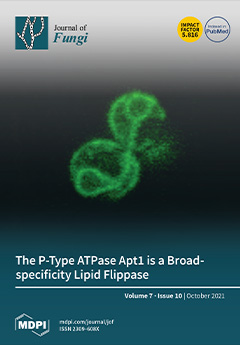- EN - English
- CN - 中文
Measuring in vitro ATPase Activity with High Sensitivity Using Radiolabeled ATP
用放射性标记的ATP高灵敏度测定体外ATP酶活性
发布: 2023年05月20日第13卷第10期 DOI: 10.21769/BioProtoc.4676 浏览次数: 2215
评审: Anonymous reviewer(s)
Abstract
ATPase assays are a common tool for the characterization of purified ATPases. Here, we describe a radioactive [γ-32P]-ATP-based approach, utilizing complex formation with molybdate for phase separation of the free phosphate from non-hydrolyzed, intact ATP. The high sensitivity of this assay, compared to common assays such as the Malachite green or NADH-coupled assay, enables the examination of proteins with low ATPase activity or low purification yields. This assay can be used on purified proteins for several applications including the identification of substrates, determination of the effect of mutations on ATPase activity, and testing specific ATPase inhibitors. Furthermore, the protocol outlined here can be adapted to measure the activity of reconstituted ATPases.
Graphical overview

Background
Through all the kingdoms of life, ATPases are the common enzyme class to catalyze reactions that would otherwise not take place due to high energy barriers. All ATPases use the dephosphorylation of ATP to ADP, resulting in the release of inorganic phosphate. Additionally, the decomposition of ATP provides energy that ATPases use for conformational changes in a variety of ways. Since most ATPases are transmembrane proteins, conformational changes enable the transport of substrates along the membrane and even against the concentration gradient.
Despite intensive research, many details on the mechanism(s) of these ubiquitous enzymes remain to be elucidated. The cellular environment is too complex to investigate one specific protein without the influence of other proteins or molecules. Therefore, most research uses a purification approach to investigate the protein of interest exclusively in the (detergent)-solubilized state or after reconstitution in model membranes, in the case of transmembrane proteins. Since substrate transport is coupled to ATP hydrolysis, one major aspect of the protein characterization is the ATPase activity. Furthermore, it is stimulated by the substrate, pH, ionic strength of the buffer, or in the case of transmembrane proteins, the lipid surroundings.
Many techniques have been used to quantify the in vitro ATPase activity of purified proteins. The most common approach to determine the ATP hydrolysis activity of ATPases is the Malachite green assay, developed in 1966 by Itaya and Ui (Itaya and Ui, 1966). This assay has been improved several times over the last few decades by different groups (Carter and Karl, 1982; Baykov et al., 1988; Geladopoulos et al., 1991; Feng et al., 2011). The method relies on the formation of a green complex when malachite green/molybdate reacts with inorganic phosphate under acidic conditions. The amount of green molybdophosphoric acid complexes can be measured with a spectrophotometer and is directly correlated with the concentration of free inorganic phosphate in the reaction. Another widely used ATP hydrolysis assay is the NADH-coupled assay (Warren et al., 1974). Here, ATP is regenerated by the pyruvate kinase, which simultaneously converts phosphoenolpyruvate to pyruvate. The latter is subsequently converted to lactate by the lactate dehydrogenase and coupled to the oxidation of NADH to NAD+. The absorption spectra of both substances at 340 nm vary significantly, allowing live absorbance- or fluorescence-based tracking of NADH consumption, and therefore, indirectly, the coupled ATP hydrolysis (Radnai et al., 2019). Based on the same principle, other fluorescence-based assays use a coupled enzyme system that catalyzes a reaction of a fluorescent substrate with a free phosphate to a product with low fluorescence (Banik and Roy, 1990). Other assays are based on a fluorescent substrate to detect free phosphate in the ATPase reaction that loses its fluorescence by binding to phosphate (Brune et al., 1994). In general, assays utilizing coupled enzyme systems have the disadvantage of being sensitive to the assay conditions, e.g., pH and/or presence of lipids. Furthermore, some ATPases cannot be purified in reasonable quantities, or their ATPase activity is low. Thus, large amounts of purified protein would be needed in the experiment, since neither the Malachite green, the NADH-coupled assay, nor the fluorescence-based assays are sensitive enough with detection limits in the low micromolar or maximum nanomolar range.
Here, we describe an in vitro ATPase assay utilizing radiolabeled [γ-32P]-ATP based on previous protocols (Gorbulev et al., 2001), with the ability to detect free phosphate in the femtomolar range. In the assay presented, the active ATPase will liberate radiolabeled gamma-phosphate from [γ-32P]-ATP. Excess radiolabeled ATP is subsequently separated from liberated radiolabeled gamma-phosphate by molybdate-phosphate extraction, in which the molybdate-phosphate complex and non-hydrolyzed ATP partition into the organic and aqueous phase, respectively. The radioactive assay provides a direct and sensitive quantification of ATPase activity. In contrast to colorimetric and fluorescent assays, this assay is not disturbed by turbidity, which can be caused, e.g., by detergents and/or lipids present in the samples. The major limitations of radioactive ATPase assays are the hazards of handling radiolabeled isotopes and the unsuitability of this assay format for large-scale high-throughput screening.
Materials and Reagents
Biological materials
The exemplary detergent-solubilized ATPase was a C-terminally GFP-tagged version of the Cryptococcus neoformans P4-ATPase Apt1p, in complex with its β-subunit Cdc50p, C-terminally FLAG-tagged (Cdc50p-Flag). The membrane transporter complex was heterologously expressed from a pESC-URA plasmid in the Saccharomyces cerevisiae strain dnf1Δdnf2Δdrs2Δ (ZHY709, Hua et al., 2002) under the control of a galactose inducible bidirectional promoter. Apt1p-GFP/Cdc50p-Flag was purified via anti-FLAG affinity chromatography, resulting in 1.026 mg/L protein in assay buffer [20 mM HEPES-NaOH, pH 7.5, 20% (w/v) glycerol, 150 mM NaCl] supplemented with 0.04% (w/v) n-Dodecyl-β-D-maltoside (DDM), stored at -80 °C (Stanchev et al., 2021).
Note: The protocol can also be applied to other ATPases, either purified or reconstituted (Gorbulev et al., 2001; van der Does et al., 2006; Marek et al., 2011; Laub et al., 2017; Theorin et al., 2019). Whether the ATPase activity of the protein remains during storage needs to be tested.
Materials
Polypropylene reaction tubes: 1.5, 2, and 15 mL (e.g., Sarstedt, catalog numbers: 72.690.001, 72.691, 62.554.502)
15 mL glass tubes with screwable lid (e.g., Oehmen, catalog numbers: 7920120, 6702588)
Note: To avoid phosphate contamination, glassware should be washed in phosphate-free detergent prior to use.
Filter tips: 10, 200, and 1,000 μL (e.g., Starlab, catalog numbers: S1120-3810, S1120-8810, S1126-7810)
5 mL pipette tips (e.g., Gilson, catalog number: F161571)
4 mL scintillation vials (PerkinElmer, catalog number: 1200-421)
Glass beakers (100 mL)
Glass flasks (500 mL)
Measuring flasks (100 mL)
Magnetic stir bars
Safety goggles
Gloves
Chemicals
N-Dodecyl β-maltoside (DDM) (Glycon, catalog number: D97002)
4-(2-hydroxyethyl)-1-piperazineethanesulfonic acid (HEPES) (Roth, catalog number: 6763.3)
Sodium chloride (NaCl) (Fisher Scientific, catalog number: 10284640)
Glycerol, >99% (VWR, catalog number: 24388.295)
Sodium hydroxide (NaOH) (Signa-Aldrich, catalog number: 30620)
Magnesium chloride hexahydrate (MgCl2) (Sigma-Aldrich, catalog number: M2670)
Isobutanol, 99% (Alfa Aesar, catalog number: B23091)
Cyclohexane, ≥99.5% (VWR, catalog number: 23224.293)
Acetone, ≥99.5% (Sigma-Aldrich, catalog number: 904082)
Adenosine-5’-triphosphate disodium salt hydrate (non-radioactive ATP) (Sigma, catalog number: A3377)
Ammonium heptamolybdate tetrahydrate, ≥99% (Roth, catalog number: 3666.1)
Scintillation fluid for hydrophilic and lipophilic samples (Roth, catalog number: 0016.3)
Hydrochloric acid (HCl) (VWR, catalog number: 20252.290)
85% (w/w) orthophosphoric acid (H3PO4) (VWR, catalog number: 20624.295)
Potassium hydroxide (KOH) (Fisher Scientific, catalog number: P564060)
[γ-32P]-ATP 3,000 Ci/mmol, 5 mCi/mL, 250 μCi (PerkinElmer, catalog number: BLU502H). Store at 4 °C, half-life is 14.29 days
Note: We recommend using this 'easy Tide' version, which includes a green dye in the liquid to aid pipetting. Furthermore, this ATP can be stored at 4 °C to avoid freeze-thaw cycles. [γ-33P]-ATP can also be used.
Sodium orthovanadate (Sigma, catalog number: 450243)
Assay buffer (100 mL) (see Recipes)
20% (w/v) DDM stock (5 mL) (see Recipes)
1 M HCl (100 mL) (see Recipes)
Reagent A (15 mL) (see Recipes)
Reagent B (33.3 mL) (see Recipes)
20 mM H3PO4 (5 mL) (see Recipes)
100 mM ATP (10 mL) (see Recipes)
500 mM MgCl2 (10 mL) (see Recipes)
700 mM orthovanadate (35 mL) (see Recipes)
Equipment
Analytical balance (Sartorius Entris-i II, 220 g/0.1 mg, Buch Holm, catalog number: 4669128)
Eppendorf Research® plus pipettes P20, P200, P1000, P5000 (e.g., Eppendorf, catalog numbers: 3123000039, 3123000055, 3123000063, 3123000071)
Thermomixer (e.g., Eppendorf, catalog number: 5382000015)
β-radiation protection shield (e.g., Thermo Fisher Scientific, catalog number: 6700-1812)
Beta Counter (e.g., Berthold, catalog number: LB 1210B)
Vortex mixer (e.g., Vortex Genie 2, Scientific Industries Inc., catalog number: SI-0236)
Scintillation counter (e.g., MicroBeta2, PerkinElmer, catalog number: 2450-0020) with sample cassette for 4 mL scintillation vials (PerkinElmer, catalog number: 1450-117)
pH meter (e.g., SevenCompact S220, Mettler Toledo, catalog number: 30019028)
Magnetic stir platform with heating option (e.g., RCT basic, IKA, catalog number: 0025005927)
Fume hood
Software
MicroBeta2 Windows Workstation Version 2.3.0.12
Microsoft Excel
Procedure
文章信息
版权信息
© 2023 The Author(s); This is an open access article under the CC BY license (https://creativecommons.org/licenses/by/4.0/).
如何引用
Veit, S. and Pomorski, T. G. (2023). Measuring in vitro ATPase Activity with High Sensitivity Using Radiolabeled ATP. Bio-protocol 13(10): e4676. DOI: 10.21769/BioProtoc.4676.
分类
生物物理学
生物化学 > 蛋白质 > 活性
生物化学 > 其它化合物 > 三磷酸核苷 > 三磷酸腺苷(ATP)
您对这篇实验方法有问题吗?
在此处发布您的问题,我们将邀请本文作者来回答。同时,我们会将您的问题发布到Bio-protocol Exchange,以便寻求社区成员的帮助。
Share
Bluesky
X
Copy link













